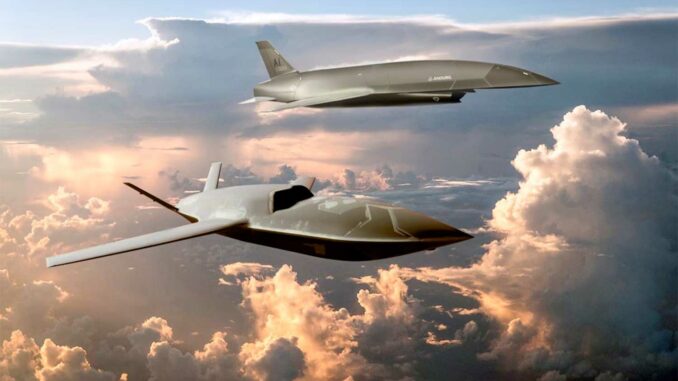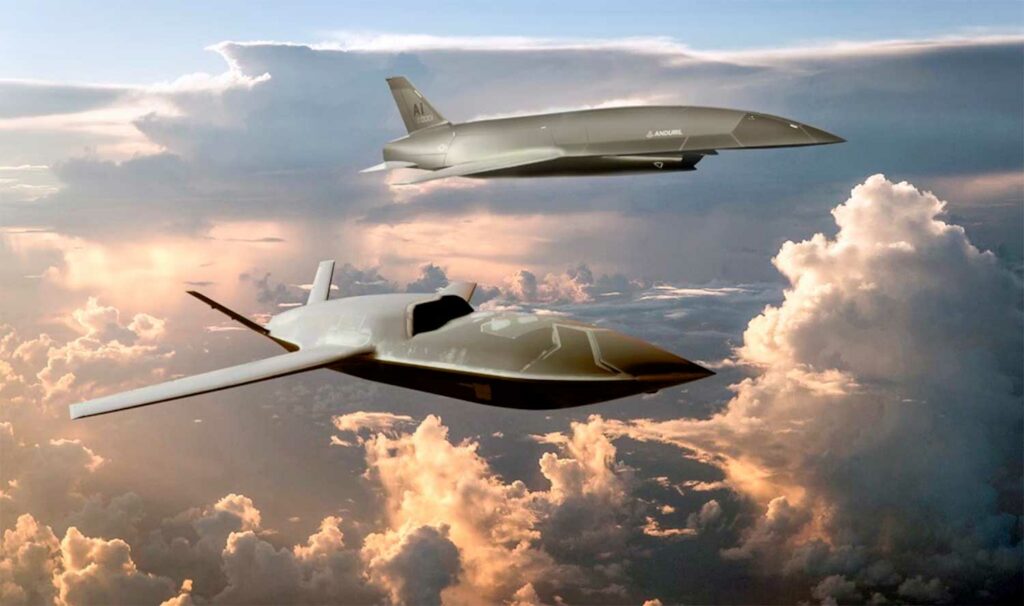
Major American engine manufacturers are accelerating the development of small turbojet engines to support the new generation of autonomous fighter jets in the CCA program.
Summary
Major American aircraft engine manufacturers—Pratt & Whitney, GE Aerospace, and Honeywell—are investing heavily in a new generation of small turbojet engines for autonomous fighter jets. These engines, delivering between 3.5 and 7.1 kN of thrust (800 to 1,600 lb), are targeting an emerging market stimulated by the American Collaborative Combat Aircraft (CCA) program. Less powerful than traditional fighter engines, they must combine efficiency, reliability, and low unit cost to meet the needs of high-volume production. This strategic shift could transform the architecture of the global military aircraft propulsion market by favoring modular models that are better suited to combat drones and collaborative swarm systems. The challenge goes beyond technology: it is also a question of securing supply and ensuring flexible production in the face of growing demand.
A new segment of engines for tomorrow’s air warfare
The rise of autonomous fighters is revolutionizing the demand for military propulsion. While an F-16 engine delivers more than 120 kN of thrust, future UCAVs require much more compact engines: from 3.5 to 7.1 kN. This reduction reflects the weight and size of these aircraft, which are designed to be lighter, more affordable, and potentially disposable.
The US Department of Defense plans to initially deploy several hundreds of CCAs starting at the end of the decade. This prospect is pushing engine manufacturers to accelerate the development of engines specifically optimized for autonomous flights, often without a pilot on board, but capable of high-performance maneuvers and extended flights at medium altitude.
A strategic opportunity for American engine manufacturers
Current programs reveal a desire to capture a market estimated to be worth several billion dollars by the 2030s.
- Pratt & Whitney is working on a range derived from its existing military engines, but adapted to smaller platforms, with simpler thermal cycles and reduced maintenance costs.
- GE Aerospace is exploring modular architectures that allow the use of components common to several models, thereby reducing production time and costs.
- Honeywell, with its experience in surveillance and support drones, is focusing on compact turbines offering excellent thrust-to-weight ratio and reduced fuel consumption for extended flights.
The development of this new segment illustrates a strategic shift: innovation is no longer focused solely on raw power, but on optimizing performance in a collaborative operational framework.
The specific requirements of autonomous fighters
CCAs must balance high performance with acquisition and operating costs that are significantly lower than those of a piloted fighter. This translates into:
- High energy efficiency, to maximize range while limiting fuel weight.
- Increased reliability, as field maintenance must remain simple and quick.
- Modular integration, allowing adaptation to various types of airframes (light fighters, escort drones, expendable effectors) .
- Reduced thermal and acoustic emissions, crucial for improving stealth and limiting infrared signature.
The engines must also be compatible with digital control architectures and hybrid power systems, anticipating future developments in collaborative combat drones.
The industrial advantage of mass production
The unit cost of autonomous fighters is expected to be 5 to 10 times lower than that of a piloted combat aircraft. This constraint requires faster and less expensive manufacturing processes, with increased use of 3D printing for complex parts and advanced alloys with high thermal resistance.
Engine manufacturers are investing in flexible production lines capable of producing several thousand units per year, compared to only a few hundred for traditional fighter engines. The challenge is to avoid bottlenecks, as the success of the CCA program will depend as much on the pace of production as on the quality of the platforms.

Integration into the CCA ecosystem
The US Air Force’s CCA program aims to supplement the F-35 and F-15EX fleets with drones capable of accompanying piloted aircraft, conducting reconnaissance and jamming missions, and even engaging in air-to-air or air-to-ground combat.
To achieve this, the engines must be adapted to:
- Swarm flights, with rapid acceleration and varied mission profiles.
- Resilient communications and controlled thermal management, essential for electronic payloads.
- Long-range operations, often exceeding 2,000 km, requiring a compromise between thrust and endurance.
Propulsion thus becomes a central element of the overall UAV architecture, determining the performance and cost of future fleets.
A disruption of the supply chain
The development of small military turbojet engines is reshuffling the deck within the industrial chain. Engine manufacturers must ensure the availability of critical materials—superalloys, ceramic composites—and develop close partnerships with equipment manufacturers specializing in digital control systems, sensors, and cooling systems.
In addition, the need for high-volume production is pushing companies to locate parts of their production on U.S. soil in order to secure deliveries and meet the requirements of the Buy American Act.
Technological and environmental challenges
The energy efficiency of small turbojets is also a major issue. Reducing specific fuel consumption not only contributes to range and cost, but also to reducing the carbon footprint, a parameter that is increasingly taken into account even in the military sector.
Manufacturers are experimenting with:
- Improved double-flow cycles, which are more fuel-efficient.
- High thermal tolerance materials, which increase efficiency without increasing weight.
- Hybrid systems, combining turbines and electrical storage for cruise or hover phases.
These advances could eventually have an impact on regional civil aviation, where small turbojet engines are still used for certain platforms.
A new paradigm for air superiority
The development of this generation of engines signals a doctrinal shift: the emphasis is moving from the extreme performance of piloted aircraft to the availability of large numbers of autonomous effectors. Engine manufacturers that can offer economical, reliable, and modular solutions could dominate this new market and influence how air forces organize their future fleets.
This shift is also redefining research priorities: logistics optimization, predictive maintenance, and hybrid systems integration are taking precedence over the pursuit of thrust records.
War Wings Daily is an independant magazine.